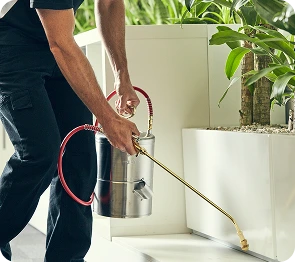Spiders Pest Control and Treatment


Spiders Pest Control
Spiders are one of the most common household pests in Australia, with over 2,000 species recorded across the country. While most are harmless and even beneficial by preying on other insects, some species — such as the redback spider, funnel-web spider, and white-tailed spider — pose serious health risks due to their venomous bites.
Unlike insects, spiders are arachnids, meaning they have eight legs and no antennae. They do not chew food but inject venom to immobilise their prey and then digest it externally before consuming it. Around the home, they can be both a nuisance and a danger, particularly in sheds, gardens, roof voids, and dark corners indoors.
What Do Spiders Look Like?
Spiders vary greatly in size, shape, and colour depending on the species. Some, like huntsman spiders, can have leg spans over 15 cm, while others, such as redback spiders, are just a few millimetres long.
Key identifying features include:
- Eight legs, often hairy or spiny
- Two main body parts: the cephalothorax (head and thorax combined) and abdomen
- Fangs (chelicerae) used to inject venom
- Silk-spinning spinnerets, which they use to create webs or egg sacs
Colours range from brown, grey, and black to more distinctive markings, such as the red stripe on a redback spider or the banded legs of orb-weavers.
Where Do Spiders Live?
Spiders are highly adaptable and can be found in almost every environment across Australia. Outdoors, they live in gardens, under rocks, in trees, and around sheds or garages. Indoors, they are commonly found in roof voids, wall cavities, corners of rooms, and other dark, undisturbed spaces.
Web-building species create visible silk structures to catch prey, while ground-dwelling species like wolf spiders or funnel-webs hide in burrows, leaf litter, or crevices.
Many spiders thrive in warm, sheltered environments with easy access to food sources such as flies, moths, and other insects. Their adaptability makes them one of the most persistent pests encountered in Australian homes and businesses.
Common Types of Spiders in Australia
Australia is home to thousands of spider species, and while many are harmless, a number of them are considered pests or even dangerous due to their venom. Some build unsightly webs around homes, others wander indoors in search of prey, and a few can deliver painful, medically significant bites.
Below are some of the most common spider species you are likely to encounter around Australian homes and why they may be a concern.
Redback Spider (Latrodectus hasselti)

How they look
Small, shiny black spiders with females the size of a 50-cent coin. The female has a distinctive red stripe down her back. Males are much smaller and rarely seen.
Where they live
They prefer warm, sheltered areas and build scaffold-like webs around garden sheds, outdoor furniture, window sills, and brick crevices.
Why they are a problem
Redbacks produce a potent neurotoxic venom. Female bites are extremely painful and can cause nausea, sweating, and in rare cases, serious illness. They are considered one of Australia’s most dangerous spiders, though anti-venom has greatly reduced fatalities.
Huntsman Spider
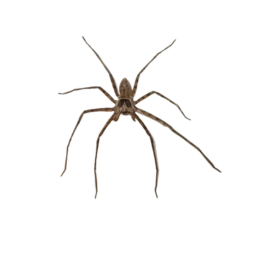
How they look
Large, flattened spiders with hairy bodies and long legs that allow them to scuttle sideways. Females grow up to 45 mm, with leg spans that can exceed 15 cm.
Where they live
Common across Australia, huntsmen are nocturnal hunters. They hide under bark, in sheds, and in roof voids during the day, and emerge at night to search for prey.
Why they are a problem
They rarely bite and are not considered dangerous, but their large size and sudden movements make them a source of fear in many households. A bite can cause local pain, swelling, dizziness, or nausea, but there are no recorded fatalities.
Black House Spider (Badumna insignis)
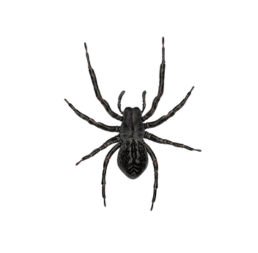
How they look
Dark brown to black spiders. Females grow up to 18 mm, while males reach 8–10 mm.
Where they live
They weave messy, lacy webs in sheltered spots such as eaves, windows, doors, and guttering, often near light sources that attract insects.
Why they are a problem
Their unsightly webs are a nuisance, and although timid, bites may be very painful, causing swelling, sweating, and nausea. In rare cases, multiple bites have been linked to skin lesions.
Funnel-Web Spider (Atrax and Hadronyche species)

How they look
Glossy, black spiders with stocky bodies and powerful fangs. Males are more active and more commonly seen than females.
Where they live
Found mainly along the east coast of NSW and Victoria. They dig silk-lined burrows in moist soil, tree stumps, or gardens, with distinctive silk “trip lines” radiating from the entrance.
Why they are a problem
Funnel-web spiders are highly aggressive when threatened. Their venom is fast-acting and can be fatal without treatment. They are considered one of the world’s most dangerous spiders, but anti-venom has prevented deaths since 1981.
Daddy Long Legs (Pholcus phalangiodes)
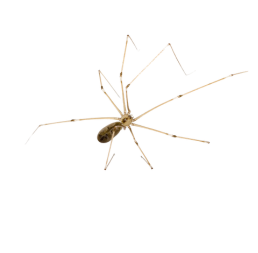
How they look
Small-bodied spiders with very long, thin legs.
Where they live
Common in homes, sheds, and garages, where they build loose, untidy webs in corners and ceilings.
Why they are a problem
They are not dangerous to humans and actually feed on other spiders, including redbacks. Their main issue is nuisance value, as their webs are messy and unsightly.
White-Tailed Spider (Lampona cylindrata and Lampona murina)

How they look
Slender, dark grey to black spiders with a distinctive white spot at the end of their abdomen. Females grow up to 20 mm, males around 10 mm.
Where they live
Common in urban areas. They wander at night hunting other spiders such as redbacks and huntsmen, hiding in clothing, bedding, or dark spaces during the day.
Why they are a problem
White-tailed spider bites are painful, though there is no scientific proof they cause ulcers or necrosis. Bites are common because they often hide in clothes or bedding, leading to accidental contact.
Trapdoor Spider (Idiopidae family)
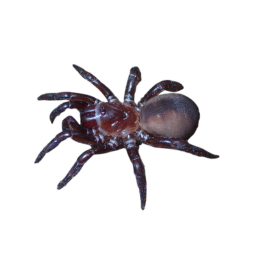
How they look
Stocky, brown to black spiders that resemble funnel-webs but are less aggressive. They are named for the hinged “trapdoor” they construct at the entrance of their burrows.
Where they live
They dig burrows in soil across Australia, especially in gardens, lawns, and bushland.
Why they are a problem
While not deadly, their bite is painful. They often alarm homeowners when encountered in gardens or dug up during landscaping.
Mouse Spider (Missulena spp.)

How they look
Robust spiders with a glossy carapace, often black or dark brown, and large fangs. Some species have brightly coloured heads, such as red or blue.
Where they live
Found across mainland Australia, they dig burrows in open ground similar to trapdoor spiders.
Why they are a problem
Some species possess venom similar to funnel-webs, though bites are rare. Their appearance and size can be intimidating, and they may pose a medical risk if disturbed.
Wolf Spider (Lycosidae family)
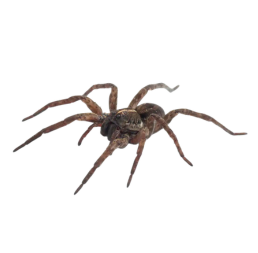
How they look
Wolf spiders are robust, fast-moving hunters with excellent eyesight. They are usually brown, grey, or black with distinctive markings on their bodies. Females can grow up to 35 mm, while males are smaller. Unlike web-building spiders, wolf spiders rely on speed and strength to catch prey.
Where they live
Common across Australia, wolf spiders live in burrows or under rocks, leaf litter, and garden debris. They are often found in lawns and gardens but may also wander indoors, especially at night while hunting.
Why they are a problem
Wolf spiders are not considered dangerous, but their bites can be painful and cause local swelling, redness, and itching. Their large, hairy appearance often makes them alarming to encounter inside homes. While bites are rare, they may occur if the spider is handled or trapped against the skin.
How to Identify Spider Infestations
Visible Webs
One of the most common signs of a spider infestation is the presence of webs. Different species weave different types of webs — messy scaffolding webs from redbacks, funnel-shaped burrows from funnel-web spiders, or fine lace-like webs from black house spiders. Webs around windows, eaves, garages, and sheds are clear indicators that spiders have set up nearby.
Wandering Spiders Indoors
Huntsman spiders, white-tailed spiders, and daddy long legs are often spotted wandering inside homes. Huntsmen are usually seen on walls or ceilings at night, while white-tailed spiders hide in clothing, bedding, or shoes. Frequent sightings indoors suggest an active infestation.
Egg Sacs
Spiders reproduce quickly, and egg sacs are a sure sign of an infestation. Redbacks can lay spherical cocoons containing up to 200 eggs, while other species spin protective sacs in webs, under bark, or in hidden crevices. Spotting multiple egg sacs means spider numbers will soon increase.
Bites and Health Risks
Unexplained bites, skin irritation, or swelling may point to spider activity, particularly from species that shelter indoors. Redback and funnel-web bites can be dangerous and require urgent medical attention, while huntsman and white-tailed bites are usually less severe but still painful.
Outdoor Harbourages
In gardens and yards, spiders often hide in woodpiles, sheds, under rocks, or in garden furniture. Funnel-web spiders are identified by burrows lined with silk trip lines, while redbacks prefer sheltered outdoor spots with ground contact for their webs.
Signs of Heavy Infestation
In serious cases, multiple webs appear across windows, gutters, sheds, and fences, making outdoor spaces look unsightly. Frequent indoor sightings of large spiders such as huntsmen or repeated discovery of egg sacs indoors are also signs of a heavy infestation. At this stage, professional pest control is strongly recommended to eliminate both adult spiders and their breeding sites.
How to Prevent Spider Infestations
Spiders play an important role in keeping insect populations under control, but when they move into homes, sheds, and gardens, they can become an unwanted nuisance — and in the case of dangerous species, a serious health risk. Preventing spiders from settling on your property is far easier than dealing with a full infestation.
By combining cleanliness, exclusion, and environmental management, you can greatly reduce the likelihood of spiders making themselves at home.
Keep Indoor Spaces Clean
Spiders prefer dark, undisturbed areas where they can hide and build webs. Regular vacuuming, dusting, and removing cobwebs from corners, ceilings, and behind furniture helps keep them away. Pay special attention to basements, attics, and cluttered storage spaces where spiders often establish nests.
Remove Food Sources (Other Insects)
Spiders are attracted to areas with high insect activity. By reducing their prey, you also reduce spiders. Store food in sealed containers, clean up crumbs immediately, and dispose of rubbish regularly to avoid attracting insects. Using yellow or sodium vapour light bulbs outdoors can also reduce night-flying insects, making your property less appealing to spiders.
Reduce Outdoor Clutter
Woodpiles, rock piles, and overgrown gardens are prime hiding spots for spiders. Keep firewood stacked away from the home and off the ground, trim shrubs and plants at least a metre away from exterior walls, and clear away leaves and debris. Cleaning gutters can also help by removing insects that spiders feed on.
Eliminate Moisture
Many spiders thrive in damp or humid areas. Fix leaking taps, pipes, and gutters promptly, and improve ventilation in crawl spaces, basements, or bathrooms. Outdoors, ensure garden beds and lawns have good drainage. A dry, well-ventilated property is far less attractive to spiders.
Seal Entry Points
Spiders often enter through small cracks and openings. Seal gaps around windows, doors, and foundations with caulk. Install door sweeps, repair damaged screens, and cover vents and chimneys with insect-proof mesh. The fewer entry points available, the less likely spiders can make their way indoors.
How to Get Rid of Spider Infestations
Spiders play an important role in controlling insects outdoors, but when they move into homes, sheds, or high-use outdoor areas, they quickly become a nuisance. Some species, like redbacks and funnel-webs, also pose genuine health risks. Preventing infestations is far easier and safer than dealing with them once populations are established.
Here are the most effective ways to keep spiders away from your property:
At-Home Actions to Get Rid Of Spiders
Keep Your Home and Yard Clean
Spiders thrive where food and shelter are abundant. Regular cleaning removes both. Vacuum ceilings, corners, behind furniture, and under beds to eliminate webs and egg sacs. Outdoors, sweep away webs from eaves, pergolas, and fences. Reduce clutter in sheds and garages where spiders often hide.
Remove Webs and Egg Sacs Early
A single egg sac can contain hundreds of spiderlings. By removing them promptly with a broom or vacuum, you stop numbers from multiplying in spring. Always wear gloves and take care if the web belongs to dangerous species like redbacks or funnel-webs.
Eliminate Insects That Attract Spiders
Spiders follow their food source. Reduce flying insects indoors by storing food in sealed containers, wiping benches, and emptying bins regularly. Outdoors, switch to yellow or sodium vapour globes, which attract fewer insects than standard lighting. Clean gutters and outdoor areas where insects gather, as this reduces the food supply that draws spiders close to the home.
Seal Entry Points
Spiders can enter through surprisingly small gaps. Inspect your home for cracks around windows, doors, vents, and utility lines, and seal them with caulk or mesh. Install or repair door sweeps and flyscreens. Cover chimneys and vents with insect-proof screens to stop entry at roof level.
Manage Moisture and Outdoor Conditions
Spiders prefer damp, sheltered environments. Fix leaking taps, pipes, and gutters. Ensure downspouts and drains are clear. Keep vegetation trimmed at least 30 cm away from walls, and store firewood and garden debris off the ground and away from the house. A tidy yard reduces both insects and spider harbourages.
Use Natural Deterrents
Essential oils like peppermint, eucalyptus, or tea tree oil — as well as diluted vinegar — can act as mild repellents. Spray around skirting boards, windowsills, and entryways to discourage spiders from settling. While not a complete solution, natural sprays complement other prevention methods.
Consider Traps and Barriers
Sticky traps placed along skirting boards, in corners, or behind furniture can help catch wandering spiders like huntsmen and white-tails. For persistent infestations, residual insecticides applied along baseboards, eaves, and entry points create a protective barrier. Always follow the label instructions and ensure products are safe for households with pets and children.
Professional Spider Treatments
While small numbers of spiders can often be managed with regular cleaning and at-home measures, long-term control is best achieved with professional treatment. Licensed pest controllers use specialised methods that not only remove spiders but also address the conditions that attract them.
Targeted Residual Sprays
Technicians apply long-lasting insecticidal sprays to skirting boards, cracks, and entry points. These treatments create a protective barrier, killing spiders on contact and preventing new ones from entering.
Dust Treatments for Hidden Areas
For locations such as roof voids, wall cavities, and subfloors, pest specialists use insecticidal dusts. These penetrate hard-to-reach areas, eliminating spiders and the insects they prey on.
Web and Egg Sac Removal
Professional treatments often include the safe removal of webs and egg sacs. Since a single egg sac can contain hundreds of spiderlings, this step is critical for breaking the breeding cycle.
Follow-Up Inspections
In cases involving dangerous species like redbacks, funnel-webs, or mouse spiders, follow-up visits may be scheduled. This helps ensure no egg sacs have hatched and that infestations are fully under control.
Call a Pest Control Professional
Spiders can be unsettling at best and dangerous at worst. While many species in Australia are harmless, venomous species like funnel-webs and redbacks pose serious health risks. Attempting DIY treatments in these cases can be risky.
A licensed pest control company can:
- Correctly identify the spider species.
- Assess the severity of the infestation.
- Apply safe, targeted treatments suited to your property.
- Provide prevention strategies to keep spiders away for good.
Eco-friendly and low-toxicity treatments are available if you want to reduce chemical use while still protecting your home.
Need help now? Book a professional spider inspection on 1300 766 614. Our experts will inspect your property, explain your treatment options, and create a tailored plan to eliminate spiders and stop them from returning.
Frequently Asked Questions (FAQ)
Are huntsman spiders venomous?
Huntsman spiders do produce venom, but it is not considered dangerous to humans. Their venom is mainly used to subdue prey. A bite can be painful and cause local swelling, redness, or mild nausea, but there are no recorded fatalities from huntsman bites.
What do spiders eat?
Most spiders are carnivorous and feed on insects such as flies, mosquitoes, moths, and ants. Some larger species, like huntsman and funnel-web spiders, may also prey on small lizards or frogs. They play an important role in controlling insect populations around homes and gardens.
How long do spiders live?
Lifespans vary depending on the species. Many common house spiders live about 1–2 years, while some, like female funnel-webs, can live for over 10 years in the wild. Male spiders generally have shorter lifespans, often surviving just 1–2 years.
Do spiders sleep?
Lifespans vary depending on the species. Many common house spiders live about 1–2 years, while some, like female funnel-webs, can live for over 10 years in the wild. Male spiders generally have shorter lifespans, often surviving just 1–2 years.
Can huntsman spiders bite?
Yes, huntsman spiders can bite if provoked, but they are generally shy and prefer to run away. Bites are rare and usually occur if the spider is accidentally trapped against the skin. While painful, bites are not life-threatening.
Pest control for the home and business
We offer expert pest eradication and prevention services for every environment – from homes and commercial kitchens to healthcare and offices. Explore the solutions we provide to keep your spaces safe, clean, and protected long-term.
Common pests we deal with
We deliver tailored, long-lasting pest control with a focus on safety, service and results.
From ants and cockroaches to bed bugs and pantry pests, we treat the full range of infestations found in Australian homes and businesses. Our trained technicians know how to identify the issue quickly and apply the right solution to remove pests – and keep them from coming back.
Ants are attracted to food sources and can contaminate food areas, often requiring professional help to locate and remove nests.
Bed bugs infestations are notoriously difficult to beat and hide in bedding and furniture, leaving bites and stains as signs of infestation.
Cockroaches thrive in warm, moist environments, breed quickly, and can leave behind odours and stains—early treatment is key.
Fleas feed on blood, mostly living off pets, and can survive dormant in the environment for months. Professional treatment is often needed.
Silverfish are fast, wingless insects that prefer warm, dark areas and can live for years, feeding on starchy or synthetic materials.
The formidable appearance and size of spiders makes them the most feared of all the creepy crawlies. However most spiders are harmless and avoid people.
Pantry moths infest dry food and can contaminate large amounts of it with webbing and droppings, regular checks and baits help prevent them.
Carpet beetles damage rugs and feed on hair, skin, and feathers, often going unnoticed until larvae husks or damage appears in hidden spaces.
Rodent control that removes the risk — fast and for good
Rats and mice pose serious health, safety and hygiene risks for homes and businesses. Our trained technicians quickly identify entry points, eliminate infestations, and implement proven prevention measures to keep rodents out for good.
Bird problems controlled with expert, long-term solutions
Birds can damage buildings, spread disease, and disrupt operations. We provide specialist bird control using proven methods and premium materials—designed to stop nesting, roosting and mess, and keep birds from coming back.
Termite protection that stops damage before it starts
Termites can silently destroy timber structures, causing costly and sometimes irreversible damage. Our licensed technicians use advanced detection tools and proven treatment systems to eliminate colonies and protect your property long-term.
Bed bug infestations found fast — and stopped for good
Bed bugs can spread quickly, cause discomfort, and damage your reputation if left untreated. Our expert team knows how to detect the early signs, eliminate infestations at the source, and prevent them from coming back with proven, long-term solutions.
National hygiene service. Local teams you can trust.
We deliver consistent, high-quality hygiene services to businesses across Australia. Unlike global franchises or contractors, our full-time staff operate nationwide—so you get reliable service, clear accountability, and a standard of care you can trust, no matter where you are.
Safe for families and pets
We work with the latest in safe pest control technologies and treatments, keeping your staff and customers safe. Our professionally trained technicians use targeted solutions at the source of the problem to keep bugs out and keep your business safe.
Our ISO1401 certification for environmental impact management and HACCP food safety certification means you can trust Competitive Pest Control Services care about the safety and protection of your facility.
Our technicians use only the safest, environmentally friendly treatments available in and around your home, to keep pests at bay giving you peace of mind as the kids continue to play in a safe and healthy environment.
There’s more to effective pest control than chemicals. We target our applications to the source of the problem from enhanced inspections to exclusion methods followed by protection.
All our treatments are environmentally friendly, because we love the Earth as much as you do. Our expertise enables us to keep chemical application to a minimum to keep the pests away, and we’re 100% carbon neutral.

